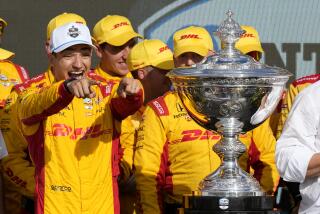Indy 500 Television : In First Start, Bobby Unser Talks Like Winner
- Share via
ABC couldn’t have planned a better ending to Sunday’s Indianapolis 500.
While Bobby Unser, the network’s new auto racing commentator working his first Indy 500, was attempting to maintain his composure, his brother Al became only the second four-time winner of the race.
“This is fabulous, absolutely fabulous,” said an emotional Unser as Al crossed the finish line. “I just cannot believe it. This has been a day. This makes up for Robby breaking his leg.”
Robby Unser, Bobby’s son, had been injured in an auto-racing crash at another track in the Indianapolis area Friday night.
Things went a little better for the Unser family Sunday. Al was a winner on the track, and Bobby was a winner in the booth.
The day didn’t go quite as well for ABC, which missed a few things, including the mishap that resulted in the death of a spectator, and made some mistakes. But considering the difficulty of covering a 500-mile race live, ABC overall did pretty well, thanks in large part to the presence of Bobby Unser.
Unser has a pleasant, home-spun broadcasting style. You excuse him for a cliche here and a gaffe there.
“That shows, don’t count your chickens until they hatch,” Unser said when leader Mario Andretti pulled off the track on lap 177, the most significant moment in the race. “Bad luck has followed Mario again. This is kind of sad.”
Someone else might have said something more eloquent, but Unser got his point across.
The fancy words are left to Sam Posey, the more cerebral of the two commentators in the ABC booth. Before the race, here’s what Posey had to say, in a language somewhat his own:
“Let me tell you this. Never before has there been a front row as strong as this one. Ever. Andretti, Rahal, Mears. Each has won the race and each is today on the top of his form. And fascinatingly, each is very different, representative of the decade, mirroring the decade, in which he won this race.
“Mario Andretti, I think of the passion and the idealism of the 1960s, of a young Italian immigrant sailing by the Statue of Liberty, but bringing with him the fiery Italian spirit, which he still drives today.
“Rick Mears, who came to prominence in the 1970s, from California, from Bakersfield, playing with motorcycles in the desert. Laid back. Even today he’d rather watch the race come to him.
“Bobby Rahal, the driver of the ‘80s, the college grad, the businessman with his briefcase and his glasses. The guy who even now as he is racing is planning ahead to his career after racing. I can’t wait for the start of this race.”
After that, Unser, using fewer and simpler words yet saying so much more, talked about the danger.
“We’ve had a lot of wrecks, probably 25 (during practice and qualifying sessions leading up to the race), and the feeling among the drivers . . . they’re a little bit scared,” he said.
Besides having vastly different styles, the two commentators disagreed on many points during the race. For one thing, Posey picked Andretti to win the race, while Unser was more cautious, refusing to predict a winner while citing how difficult it is to go the distance in “this doggone race.”
It’s a good match. With Unser around, Posey, his role lessened, wasn’t as offensive as he has been in past Indy 500 telecasts. He couldn’t talk as much, and that was a break for the viewers.
Lap-by-lap announcer Jim Lampley, who had the same assignment last year when the race was televised live for the first time, was improved, and handled some difficult situations well.
At one point, Lampley said Andretti had been dealt a “stop-and-go” penalty for passing under a yellow flag. But there was no penalty.
After pit reporter Jack Arute said Andretti’s crew knew nothing of the penalty, Lampley explained that ABC had picked up the information from USAC officials discussing it over a radio frequency being monitored by the network’s production people.
Arute later reported that USAC officials said there was no infraction and no discussion of any penalty on the track radios, but Lampley said ABC had heard something.
Sometimes, things happen during a live telecast that can’t be helped, like when Arute started to interview Rahal after the defending champion dropped out. But then Danny Sullivan spun onto the dirt, and ABC had to cut away from the Rahal interview for a report on Sullivan’s mishap.
ABC next showed Sullivan’s spin in 1985, when he went on to win the race. The timing of the piece was good, but ABC never went back to Rahal. Viewers were left hanging.
ABC totally missed the accident that killed spectator Lyle Kurtenbach, 41, of Rothschild, Wis. Kurtenbach died when struck by a tire that was knocked off Tony Bettenhausen’s car.
Viewers were unaware of the mishap until Jim McKay read an Associated Press report after the race.
Also, ABC didn’t have any clear replays of Tom Sneva hitting the wall on the 143rd lap.
But the drama at the end--the pictures of Karen Unser during husband Al’s final lap, the words from Bobby as he watched his brother make history and then Al and Bobby being able to speak to one another shortly after the finish--more than made up for the flaws in the telecast.
More to Read
Go beyond the scoreboard
Get the latest on L.A.'s teams in the daily Sports Report newsletter.
You may occasionally receive promotional content from the Los Angeles Times.










